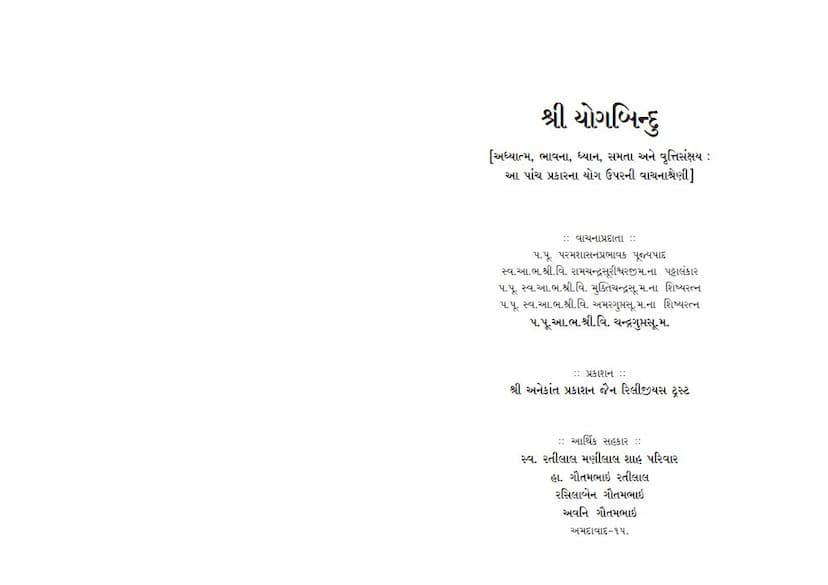Yogbindu Vachna
Added to library: September 2, 2025

Summary
Here's a comprehensive summary of the provided Jain text, "Yogbindu Vachna" by Chandraguptasuri, based on the given pages:
The text is a discourse (Vachna) on the Jain scripture "Yogbindu" by Acharya Haribhadrasurishwarji, delivered by Acharya Bhagwant Shri Chandra Guptasuriji. The discourse focuses on the five types of Yoga: Adhyatma (Self-reflection), Bhavna (Contemplation), Dhyan (Meditation), Samata (Equanimity), and Vruttisankshay (Cessation of mental modifications). The overall aim is to explain the path to liberation (Moksha) as described in Jain philosophy.
Key Themes and Concepts:
-
The Goal of Moksha: The discourse repeatedly emphasizes that the ultimate goal of all spiritual disciplines and philosophies is Moksha (liberation). All true scriptures and enlightened beings guide individuals towards this singular objective.
-
Distinguishing Dharma (Religion) from Yoga: A significant point of emphasis is the difference between "Sthool Dharma" (gross or conventional religious practices) and "Yoga."
- Sthool Dharma: Primarily leads to the accumulation of punya (merit) and subsequent worldly pleasures (like going to celestial realms). It offers temporary happiness but doesn't lead to liberation.
- Yoga: Primarily leads to nirjara (shedding of karma) and ultimately Moksha. It involves detachment from both pleasure and pain, focusing on inner purification.
-
The Nature of Happiness and Suffering: True happiness is not found in worldly pleasures, which are transient and ultimately lead to suffering due to their impermanence and the attachment they foster. Suffering itself is not the obstacle; rather, attachment (rati) and aversion (aranti) to experiences, whether pleasant or unpleasant, bind karma. Yoga cultivates the ability to detach from these attachments and aversions, turning even difficult situations into opportunities for karmic shedding.
-
The Importance of Adhyatma (Self-Reflection) and the Path: The discourse highlights that true spiritual progress begins with understanding the nature of the self and the world. It criticizes those who are satisfied with worldly pleasures or seek superficial religious benefits, urging listeners to focus on the subtle path of Yoga that leads to true liberation.
-
Haribhadrasurishwarji's Contribution: Acharya Haribhadrasurishwarji is praised for his extensive work on Yoga, including the "Yogbindu." His writings are presented as a means to understand the profound truths of Jainism, which are universal and acceptable to all philosophical schools if approached with an open mind.
-
The Role of the Guru and Scriptures: The importance of a qualified Guru is stressed for understanding the true meaning of scriptures. Devotion to the scriptures and the teachings of the Tirthankaras is paramount.
-
The Five Types of Yoga Explained:
- Adhyatma: The practice of contemplating the true nature of the self, distinguishing it from the body and other worldly attachments. It involves righteous conduct according to one's stage of spiritual development (Gunasthan). The core of Adhyatma is self-reflection guided by the scriptures and a pure intention, not mere intellectual contemplation or external adherence.
- Bhavna: The continuous, deep contemplation of the principles discussed in Adhyatma. It involves repeatedly reflecting on the nature of the self, the impermanence of the world, and the path to liberation. The development of Bhavna requires sustained effort and a calm mind.
- Dhyan: A state of deep concentration on a single, pure subject (like the soul's true nature) without wavering. It is characterized by mental stillness and a profound understanding of the object of meditation, leading to the cessation of distracting thoughts.
- Samata: Equanimity, achieved through right knowledge and understanding. It arises from realizing that worldly things are neither inherently desirable nor undesirable. It's a state where one is not swayed by external pleasures or pains, as their temporary nature is understood. This equanimity is a product of deep knowledge gained through Dhyan.
- Vruttisankshay: The ultimate cessation of all mental modifications (vruttis) and karmic influx. This is the state of liberation, achieved through the culmination of the preceding yogic practices.
-
The Distinction Between "Correct" and "Incorrect" Yoga/Practices:
- Correct Yoga: Is aimed at liberation, follows the teachings of the Tirthankaras, is pursued with a pure intention and effort, and leads to karmic shedding and spiritual progress. It emphasizes detachment and understanding the impermanence of worldly existence.
- Incorrect Yoga/Practices: Are those that are self-serving, worldly-minded, lead to the accumulation of karma, or are based on misconceptions about the nature of the self or the path to liberation. Examples include seeking worldly benefits, performing rituals without true understanding, or misinterpreting scriptures.
-
Critique of Other Philosophies (Subtle but Present): While the "Yogbindu" aims to be acceptable to all, the discourse subtly critiques other systems, particularly those that rely on external deities or favor external rituals over internal purification and self-effort. The emphasis is on self-reliance and the direct path to liberation through one's own efforts, guided by the Tirthankaras.
-
The Importance of Right Understanding and Effort: The text strongly advocates for understanding the true essence of the teachings rather than mere adherence to outward forms. It highlights that mere knowledge without practice, or practice without right knowledge, is insufficient. Both diligent effort (Purusharth) and the right path are crucial for achieving liberation.
In essence, "Yogbindu Vachna" serves as an in-depth exposition of the "Yogbindu" scripture, aiming to guide individuals towards a profound understanding of the Jain path to Moksha, emphasizing introspection, detachment, and diligent spiritual practice under the guidance of the Tirthankaras and the Guru.